SOME PRELIMINARY TUTORIALS FROM THE ANCIENT PARCEL
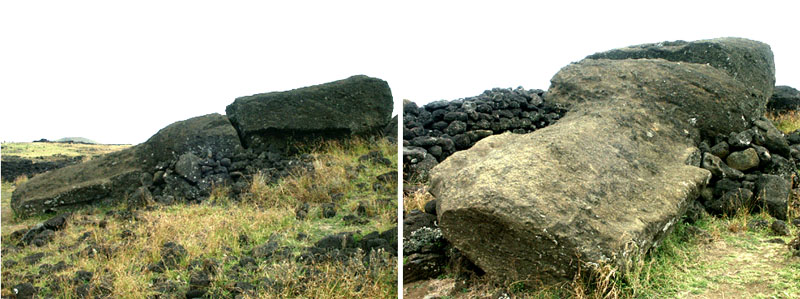
This is the image supplied by the Rapa Nui archaeological
database of the largest of the moai statues "known to have been standing",
which is called "Pito Kura" (naval or belly-button of the world).
It is situated on the remote northern coastline, at a point approximately
2/3rds the way across the island's length to the east. Its position is given
as: Latitude: -27.0853474140766, Longitude: -109.301541651601. It has been
tumbled and broken through the chest. The moai reposes with the head pointing
towards 230-degrees azimuth and, when standing, would have looked towards
the south.
Pito Kura once stood 32-feet tall. Dr. Jo Anne Van Tilberg of
UCLA measured this moai as 979 centimetres overall length, which equates to
32.12-feet. In addition, it's top knot, which was once locked by its immense
weight into a dished peg supportive arrangement of stone on the top of the
head, was 5.9-feet in height. Van Tilberg measured this pukao (top knot) as
1.8-metres high by 2.59 metres wide (very close to 8.5-feet).
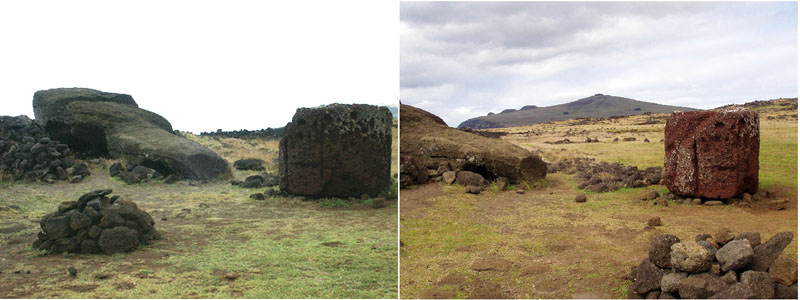
Two views of the very red-coloured, lava-stone top knot
of Pito Kura, where it came to rest after the giant moai was unceremoniously
tumbled. The hill in the background has a carved summit plateau facing NW
around to NE and its centre top (a shallow volcanic cone trough with trees
protruding) was once the resolving position for multiple surveying lines.
This will be demonstrated as we proceed.
It must be realised that these free standing moai on ahu platforms
were code bearing monuments in terms of height and girth measurements and
many tutorials were built into their dimensions. The code for Pito Kura's
overall height, with the top knot in place and locked slightly downwards and
into the dished top of the head, seems to have been 37.8 feet overall. This
is a very strong navigational code and half the base length of the Great Pyramid
of Egypt is 378-feet, which is 1/16th of 1-minute of arc under the pyramid's
system for measuring the Earth's equatorial circumference.
The top knot itself is very easy to read. Its intended height
was 5.90625- feet or 70.875-inches
(70 & 7/8ths). Let's look at other artefacts and edifices ranging from
Egypt to France to Mexico that carry this same coding:

The Great Pyramid (top right) has a length of 756-feet
per side or a half length of 378-feet. Two full circumnavigations of the Pyramid
equated to 6048-feet, which was 1-minute of equatorial arc. In other words,
this length (6048-feet) X 60 X 360-degrees = a full circumference of 24883.2-Greek
miles of 5250-feet each (12 X 12 X 12 X 12 X 1.2). This was the preferred
Greek method of using the number families "6&7"combined for
their navigational system. Other European nations, including the Saxons, preferred
to use the "11" family of numbers. By elongating the pyramid's side
length reading by 3-inches to 756.25-feet, this second system came into play,
with 6050-feet representing 1-minute of equatorial arc in a world with a circumference
of 24750 British miles of 5280-feet each. There were other navigational systems,
including an Egyptian and a Roman one which viewed the equatorial circumference
as 25000 Greek miles (27000 Roman miles, based upon a mile of 58333.33333
Roman feet @ 11.66666-inches each ... 11 & 2/3rds). The pyramid has a
slope angle of 51.84-degrees and covers an area at the base of 5184 square
Reeds (a Reed is 10.5 British feet or 10 Greek feet of 12.6-inches each).
The diagonal length up a face to the edge of the flat floor on top (it never
had a pointed capstone in all recorded history) is 576-feet or 288-feet X
2. The Aubrey Circle at Stonehenge is 288-feet wide.
To the bottom left of the picture is Khafre Pyramid,
which has a side length that is 15/16ths that of the Great Pyramid, or 708.75-feet.
This is Egypt's Pyramid of the moon and all of its measurements relate to
the lunar cycle. For example, half its base length is 354.375-feet
and there are 354.375-days in a lunar year. It's also built to a perfect 3,4,5
triangle method, used by builders, architects and surveyors since time immemorial.
The increment used to form the 3,4.5 triangle was 118.125-feet (118 &
1/8th ... note 4 lunar months is 118.125-days) Therefore: Half the base length
(354.375-feet or 118.125 X 3) = the Adjacent; The vertical height (472.5-feet
or 118.125 X 4) = the Opposite; The side face slope or diagonal length (590.625-feet
or 118.125 X 5) = the Hypotenuse.
One full circumnavigation of the Khafre Pyramid is 2835-feet
and that also happens to be the internal length of the ancient Octagon earth
embankment complex of Newark, Ohio. In addition to that the azimuth angle
of the Octagon's length (from the altar alcove of the circle - through the
connecting avenue - dissecting the octagonal complex - to the outer edge of
the gateway) is 2835-feet. The azimuth angle of that dissecting line is 51.84-degrees
around from north and the slope angle of the Great Pyramid is 51.84-degrees.
It's significant to add that the half value of 59.0625
(59 & 1/16th) is 29.53125 (29 & 17/32nds) and that this number
of days is the length of a lunar month to a tolerance of under 1-minute.
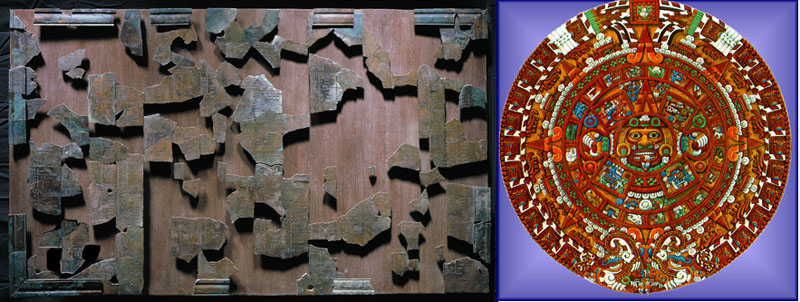
Left: The ancient brass Calendar of Coligny plaque of
Druidic France. It has a width of 2.953125-feet
or 35.4375-inches. Its width is exactly half
the measured height of the top-knot stone of Pito Kura moai at Easter Island.
Right: The Aztec Calendar stone from Mexico. It has a measured diameter of
11.8125-feet or 5.90625
X 2. This diameter is exactly twice the height of the top-knot stone
of Pito Kura moai.
So what does this north-south distance of 19800-feet and what
was the dynamic lesson built into this length?
The ancient mathematical tutorial built into this traversal
of Easter Island, from coast to coast, relates to the
diameter of the Earth in the following way:
- The diameter of the Earth at the equator is very close to 7920-miles (literally
7923.29-miles). One quarter of this distance would be 1983.07-miles.
- The ancient mathematicians devised several navigational systems, each based
on different number families. For simplified navigational calculations they
needed highly factorable numbers that were easy to manipulate and reduce by
fractions. Under the literal system demonstrated in the base dimensions of
the Great Pyramid, the Earth's circumference was read as 12 X 12 X 12 X 12
X1.2 (24883.2) miles of 5250-feet each. This gave a diameter of 7920-miles
using PI @ 3.141818182.
- Under the a second reading of the Great Pyramid system, the equatorial circumference
was considered to be 24750-miles of 5280-feet.
- Under a third reading the Earth's circumference was considered to be 24883.2-miles
of 5280-miles. This is the mile that survived in Britain.
- Three slightly different Egyptian Royal Cubits existed as dedicated expressions
to each of the above systems, which were 20.61818182-inches, 20.625-inches
and 20.736-inches respectively.
- Under an Egyptian method the world was considered to be 5000 Atur of 26250-feet
each (5 Greek miles of 5250-feet each). The same world circumnavigating distance
would equate to 25000 Greek miles or 27000 Roman-miles.
It can be seen from the above that there were several close
proximity values used by various ancient cousin civilisations to describe
the diameter of the Earth, ranging from 7920-miles to 7294.545454-miles. At
Easter Island it appears that provision was made for tutorials in each of
the systems and that the diameter of the island at this point represented
a measurable, fraction expression of that distance.
Whereas the width of the island, in this instance, was coding
the width of the Earth, a carefully chosen distance going on a line due west
from this dot marker was coding the equatorial circumference of the Earth.
Let's see how that worked.
MORE TRIGS
In traditional surveying methodology, before the days of global
positioning technology, the surveyor relied upon any high points within the
circuit of vista to fix onto, in order to triangulate positions and calculate
both distances and angles accurately. Each of the high points of Easter Island
would have been exploited in this way from multiple viewing stations across
the island and no target moreso than the highest point at Mt. Teravaka (650
metres).
Another, more central hillock mound, position was used as a
primary benchmark for groundmarked north, south, east & west fixes. In
a sense it might be more reasonable and realistic to call this position Te
Pito Kura or the naval / belly-button of Easter Island.
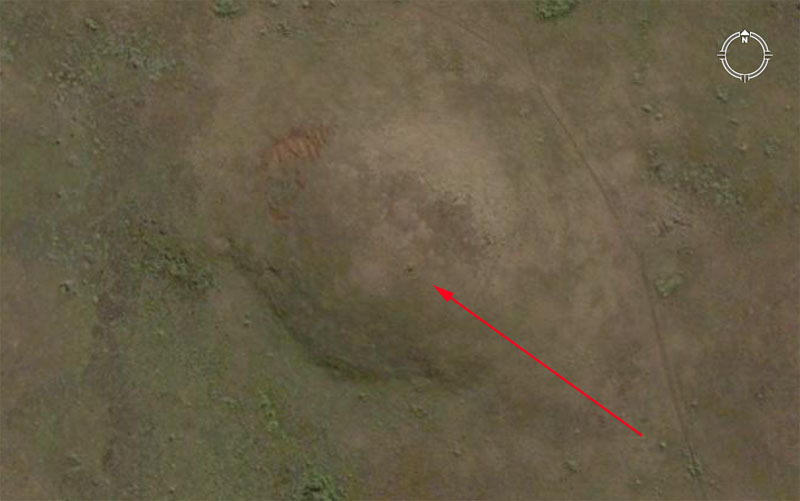
The central mound at Easter Island, which has a marker
position situated at latitude -27.111812, Longitude -109.295761 (Google Earth
coordinates). In the latest image supplied by Google Earth the hump is not
as clear, but is still detectable. This large volcanic mound upon which the
marker sat was, undoubtedly, formed naturally due to upthrusting magma pressure
from beneath the ground when the area was an active volcanic field. A surveying
plan was built around its position by the ancient architects of the Easter
Island navigational school, leading to the establishment of marked stations
on the coastlines to the north, south east & west. Let's see what was
built at a coded distance due north of this marker.
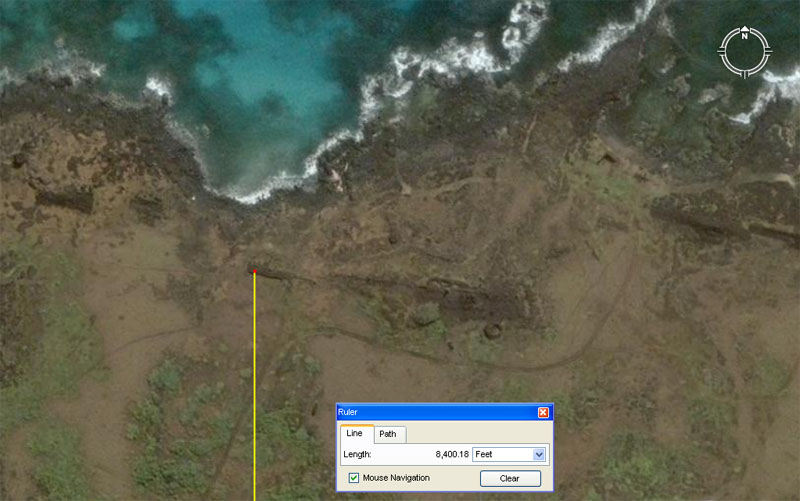
Situated 8400-feet to the north is a ruined ahu platform
and the due north line resolves upon its western end. Other ahu platforms
can be seen to each side. The 8400-feet distance to the platform is a very
strong navigational value related to the equatorial size of the Earth, as
encoded into the dimensions of the Great Pyramid of Egypt. The sum of 8400-feet
would equate to 8000 Greek feet of 12.6-inches each or 800 Hebrew Reeds. This
distance would also be 4000 Assyrian cubits of 25.2-inches. or 1.6 Greek miles
of 5250-feet each. The same distance would be 8460 Roman feet of 11.66666-inches
(11 & 2/3rds).
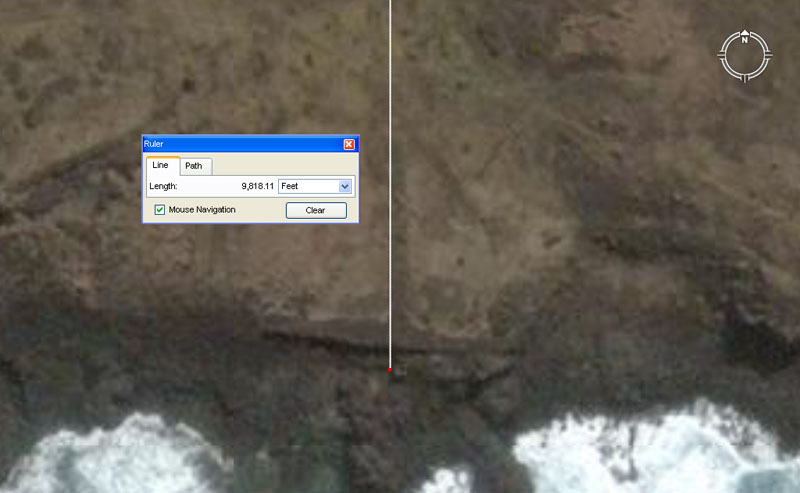
The south running line from the mound marker in the
centre of the island dissects one of two stone markers in the final approaches
to Ahu Hanga Pu Ngao. Another stone marker on this alignment sits on the ahu
platform itself, with a final position relating to the water's edge. On the
final approach to the ahu the ancient architects formed a continuous, wide
ground blanket of stones to very vividly indicate a north - south line. That
dark blanket can be seen to the side of the white line in the above picture
and it is a very old, purpose built feature. Let's now look at the codes of
distance from the mound to markers on the southern coastline.
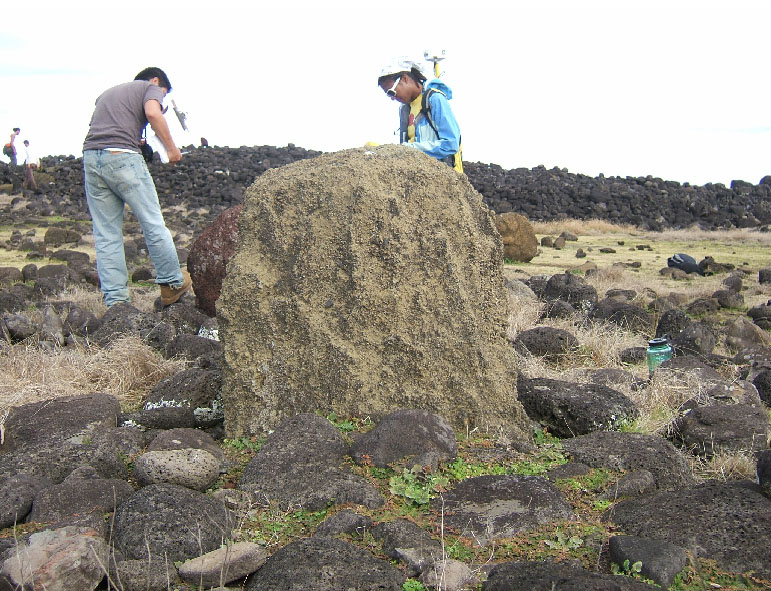
Modern-day surveyors associated with the Rapa Nui Archaeological
Database incentive, logging the positions of the moai and other markers, take
a fix on stone 0914. It sits upright and undisturbed in the middle of the
stone blanket covering the ground, which forms a wide and very conspicuous
north-south line on the approach to the ahu pile platform (seen in the background).
This particular outer-marker relates directly to the moai markers on the ahu
and not to the distant benchmark mound further inland. The design intention
of the original architects was to have this marker sit 118.125-feet due north
of the central marker moai (0200) situated on the platform.
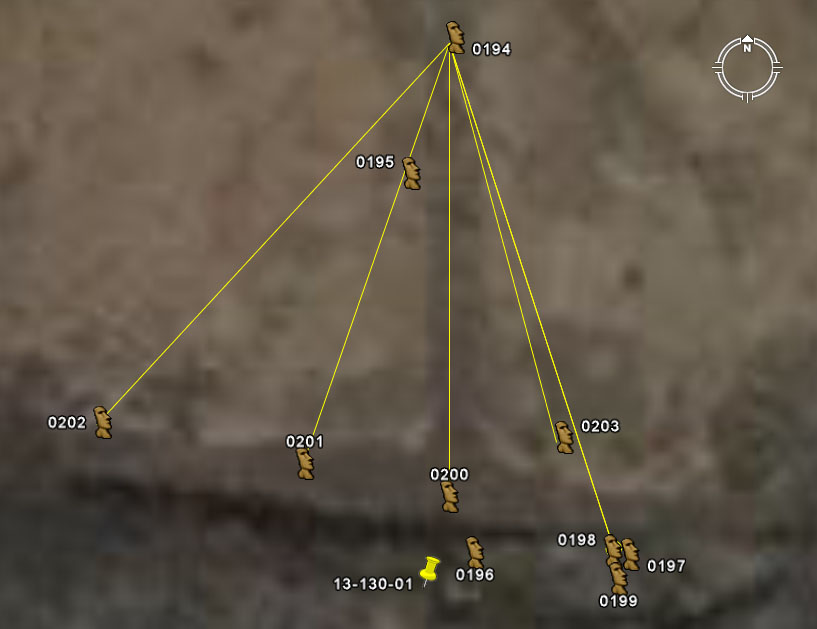
With stone 0914 representing the primary hubstone for
the immediate site, here are the probable codes of placement intended by the
original architects. The stones listed as 0195, 0916 or 13-130-01 (nomenclature
from a separate system of surveying) seem to relate directly to the more substantial
north-south alignment extending from the inland mound. The blurred background
picture is Ahu Hanga Pu Ngao from only 250-feet above the ground in the Google
Earth image.
The above sample analysis is offered as the "probable" codes and
certainly as an insight into how each of the ahu platforms around the island
was intended for use by the originally designers of the open air university
of navigation. The unknown factor is the extent the carefully placed monument
stones have been disturbed when the sites were wrecked. The point is: The
Easter Island layout of markers and what they meant to the ancient architects
constitutes a totally solvable problem for surveyors.
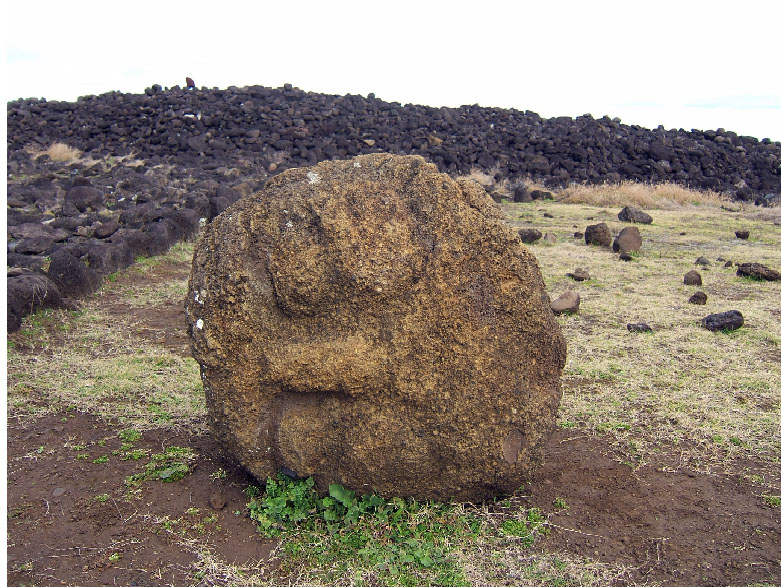
This is stone 0195 and it now lies to the side of the
stone ground blanket or causeway leading to the ahu. It has been rolled a
short distance sideways off the causeway to this position, but the face on
it looks not towards the ahu but back north towards the inland mound. It sits
a coded distance of 9720 feet from the inland mound's benchmark position.
The value 9720 is a strong navigational and lunar number simultaneously, which
in a mathematical progression, delivers up a string of highly useful values,
much used in antiquity. For example:
972, 1944 (the ancient Greek Chous liquid volume was
194.4 cubic inches), 2916, 3888, 4860, 5832 (The Roman Pace was 58.32-inches),
6804 (The lunar nutation cycle endures for 6804-days), 7776 ( the sum of 777.6-miles
was 1/32nd of the equatorial circumference under the Great Pyramid standard
... the Sumerian-Babylonian "Mina" weight was 7776 grains), etc.,
etc.
All of the values generated in the chosen distances and angles between markers
at Easter Island will prove to be based upon well-known Mediterranean and
ancient European measurements. The numbers generated will prove to be the
common, repetitive values found copiously in the ancient grain weight's standards
or volume standards for each and all of the ancient Mediterranean or Continental
European civilisations.
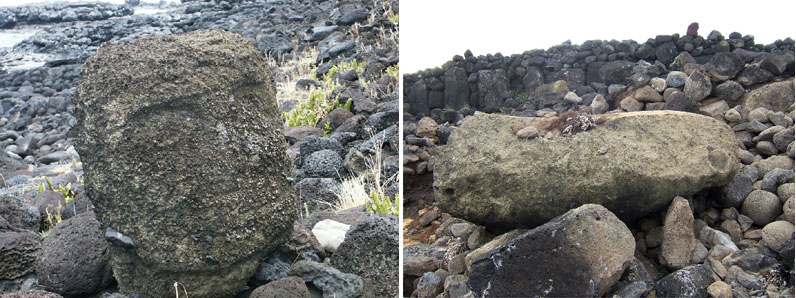
The tumbled end markers on the seaward side of the Ahu
Hanga Pu Ngao platform. The probable distance coding was 9900-feet (1.875-miles)
from the inland mound to where the sea lapped the shore (at high tide). A
shoreline marker probably once sat at 1.875 Greek miles (9845.75-feet) from
the inland mound ... (a very important lunar code and the grain weight of
the Beqa gold standard used in the Egyptians, Romans and Greeks was an expression
of this @ 196.875 or 2 X 98.4575 grains). The probable coded distance from
the inland mound to the ahu platform was 9800-feet or 1& 13/15ths Greek
miles. The main coded marker from the inland mound was the carved face (0195)
lying on its side at 9720-feet distance.
EAST - WEST CODES.
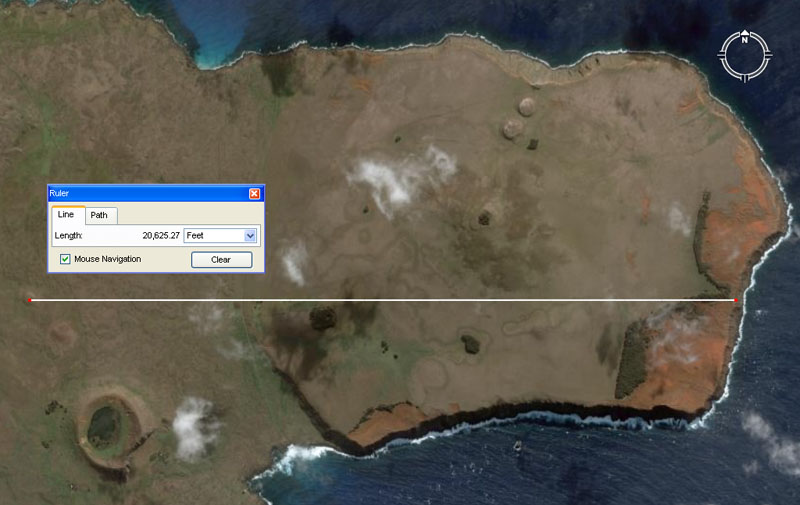
From the marker on the inland mound the eastern alignment
runs 20625-feet to the edge of the cliff above the sea. The Egyptian Royal
Cubit related to the mile of 5280 feet was 20.625-inches. This distance would
be 3072 Egyptian Royal Cubits. The sum of 17.6 such lengths would represent
1-degree of arc (68.75-miles) under the Great Pyramid's second navigational
assignment (the "11" family system of numbers) that configured the
equatorial circumference as 24750-miles.
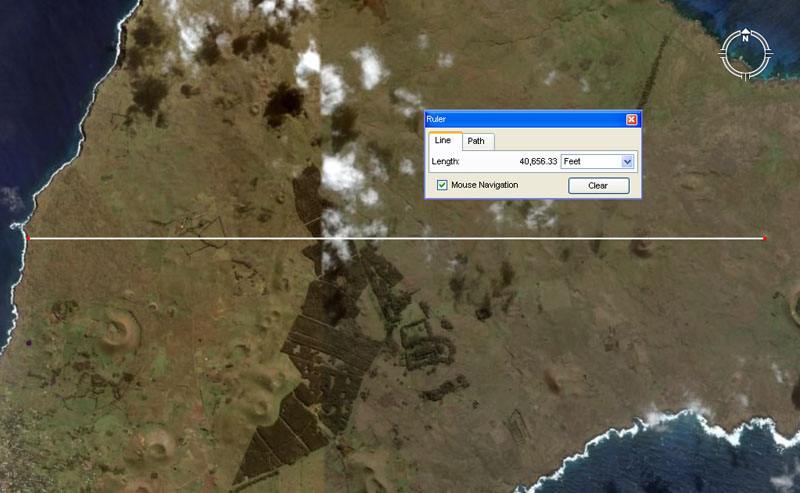
From the refined benchmark point on the inland marker
mound, the line westward runs 7.7-miles to resolve on, what looks like, an
arrow excavation in the terrain bordering on the cliff above the sea.
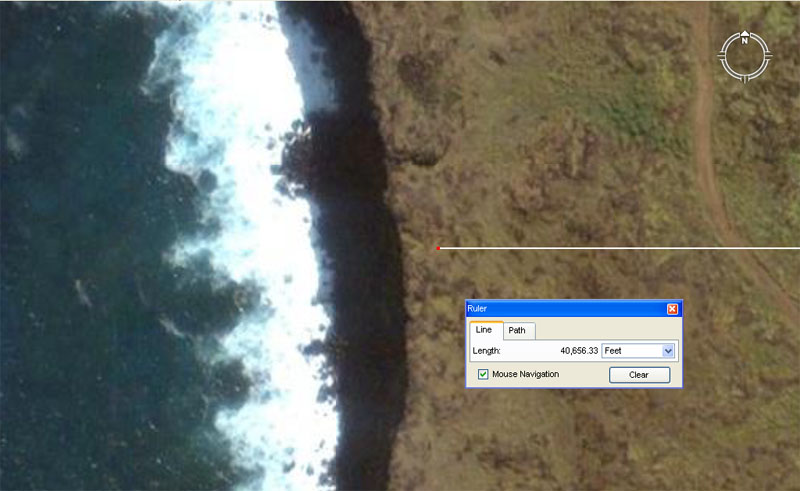
The westward running line seems to resolve onto an arrow
shaped trench excavation, which points back to the inland mound 7.7-miles
distant.
It is clearly beyond dispute that ancient, purpose-built, surveying
stations have been put in place at Easter Island to give fixes onto true north,
south, east and west. The chosen distances and angles are very recognisable
old world standards from the Mediterranean and Europe. Once these foundation
alignments were established, a larger series of secondary orientations or
code-bearing backsight positions were put in place to offer navigational tutorials
to initiates and apprentices. The student navigators could go from ahu platform
to ahu platform and carefully extract the unique information encoded into
each.
We will now circumnavigate the coast to show the many ahu platforms
linked by positional codes of distance and angle. Nothing at Easter Island
was arbitrary or meaningless and everything carried tutorials, which could
be extracted and understood by precise surveying.













